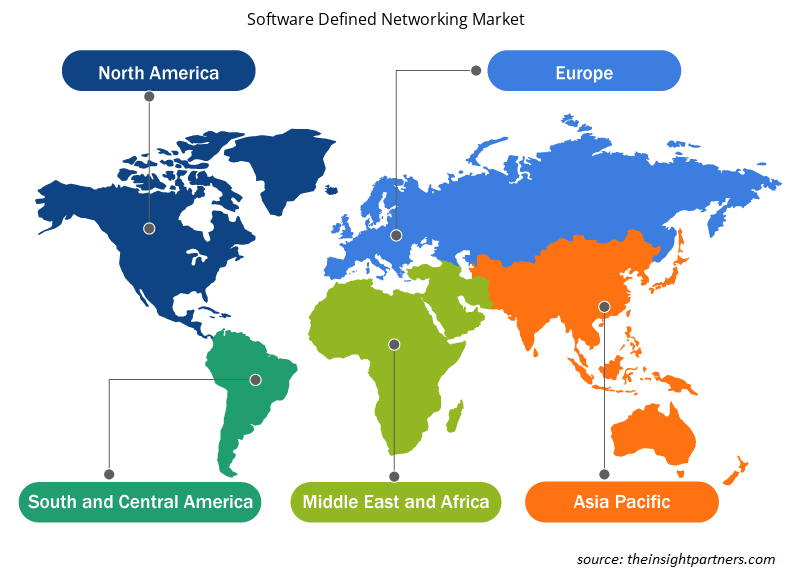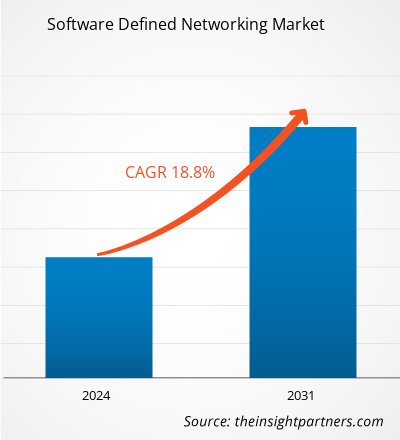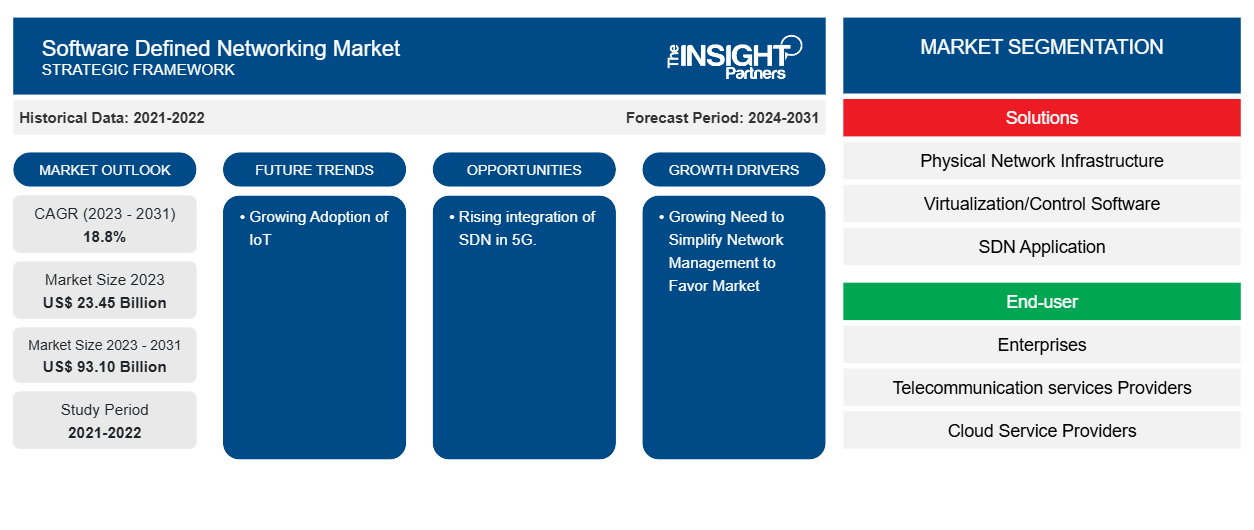Si prevede che la dimensione del mercato del networking definito dal software raggiungerà i 93,10 miliardi di dollari entro il 2031, rispetto ai 23,45 miliardi di dollari del 2023. Si prevede che il mercato registrerà un CAGR del 18,8% nel 2023-2031. La crescente necessità di semplificare la gestione della rete e la crescente implementazione di SDN per 5G rimarranno probabilmente le principali tendenze del mercato del networking definito dal software.
Analisi di mercato del software di rete definito
Il mercato del networking definito dal software sta crescendo a un ritmo rapido e alimenta la crescita del mercato poiché le organizzazioni IT si stanno spostando rapidamente verso la tecnologia cloud. Le aziende e le entità IT hanno i vantaggi associati a ruoli ed eventi a livello di applicazione per efficienza funzionale e resilienza. Ciò consiste in automazione dei servizi di rete, integrazione cloud e servizi di automazione ibrida. Attualmente, diverse aziende stanno generando applicazioni di servizi di rete per software per SDN al fine di aggiungere un valore di virtualizzazione a un nuovo standard consentendo a tali servizi di avere un impatto vigoroso sull'infrastruttura per conto delle applicazioni e della loro usabilità.
Panoramica del mercato del networking definito dal software
Utilizzando controller basati su software o interfacce di programmazione delle applicazioni (API) per connettersi all'infrastruttura hardware sottostante e gestire il traffico su una rete, il software-defined networking, o SDN, è una tecnica di networking. Questo approccio è diverso dalle reti tradizionali, che gestiscono il traffico di rete con componenti hardware specializzati come switch e router. SDN può utilizzare software per creare e gestire una rete virtuale o gestire hardware convenzionale.
Personalizza questo report in base alle tue esigenze
Riceverai la personalizzazione gratuita di qualsiasi report, comprese parti di questo report, o analisi a livello nazionale, pacchetto dati Excel, oltre a usufruire di grandi offerte e sconti per start-up e università
-
Scopri le principali tendenze di mercato in questo rapporto.Questo campione GRATUITO includerà analisi di dati che spaziano dalle tendenze di mercato alle stime e alle previsioni.
Driver e opportunità del mercato del networking definito dal software
Crescente necessità di semplificare la gestione della rete per favorire il mercato
Uno dei principali fattori che spinge il settore del software-defined networking (SDN) è la crescente necessità delle aziende di semplificare l'amministrazione di rete. Le reti convenzionali hanno spesso configurazioni complesse e procedure di amministrazione manuale, che aumentano le spese e si traducono in inefficienze. SDN offre un'interfaccia coerente per il controllo di una varietà di dispositivi di rete, centralizza il controllo di rete e consente l'automazione per superare queste difficoltà. Questo metodo centralizzato facilita un approccio indipendente dal fornitore, velocizza il provisioning di rete, semplifica la gestione delle policy e migliora la visibilità delle prestazioni di rete. SDN è un'opzione valida per aggiornare le infrastrutture di rete e adattarsi alle mutevoli esigenze aziendali poiché semplifica le operazioni, il che consente alle aziende di risparmiare denaro, tempo e risorse.
Crescente integrazione di SDN nel 5G.
SDN è un'architettura di rete intelligente conforme agli standard dell'ecosistema 5G. Il 5G può funzionare su un piano di controllo con l'aiuto di SDN, che può offrire un framework completo. Flussi di dati migliori quando i dati viaggiano attraverso la is an intelligent network architecture that complies with 5G ecosystem standards. 5G can operate over a control plane with the help of rete 5G sono solo uno dei tanti vantaggi offerti da questa tecnologia. L'architettura SDN riduce la latenza e massimizza la larghezza di banda della rete. Identificando i migliori flussi di dati in tempo reale, la tecnologia SDN può automatizzare e gestire la ridondanza di rete da un piano di controllo centralizzato, evitando interruzioni significative.SDN, which can offer an entire framework. Better data flows when data travels across the SDN architecture reduces latency and maximizes network bandwidth. By identifying the best data flows in real-time, SDN technology can automate and manage network redundancy from a centralized control plane, avoiding significant outages.
Analisi della segmentazione del rapporto di mercato del software Defined Networking
I segmenti chiave che hanno contribuito alla derivazione dell'analisi di mercato del software defined networking sono soluzioni, utenti finali, distribuzione e settore verticale.
- In base alle soluzioni, il mercato del networking definito dal software è suddiviso in infrastruttura di rete fisica, software di virtualizzazione/controllo, applicazioni SDN e servizi professionali.SDN applications, and professional services.
- In base all'utente finale, il mercato è segmentato in aziende, fornitori di servizi di telecomunicazione e fornitori di servizi cloud.
- In base al settore verticale, il mercato del software defined networking è suddiviso in servizi bancari e finanziari e assicurazioni, telecomunicazioni e IT, beni di consumo e vendita al dettaglio, governo e difesa, produzione, ricerca e mondo accademico e altri.
Analisi della quota di mercato del software defined networking per area geografica
L'ambito geografico del report di mercato del software defined networking è principalmente suddiviso in cinque regioni: Nord America, Asia Pacifico, Europa, Medio Oriente e Africa e Sud America/Sud e Centro America. Il Nord America ha dominato il mercato del software defined networking. Le tendenze di adozione di tecnologie elevate in vari settori nella regione nordamericana hanno alimentato la crescita del mercato del software defined networking. Si prevede che fattori tra cui una maggiore adozione di strumenti digitali e un'elevata spesa tecnologica da parte delle agenzie governative guideranno la crescita del mercato del software defined networking nordamericano. Inoltre, una forte enfasi sulla ricerca e sviluppo nelle economie sviluppate degli Stati Uniti e del Canada sta costringendo gli attori nordamericani a portare sul mercato soluzioni tecnologicamente avanzate. Inoltre, gli Stati Uniti hanno un gran numero di attori del mercato del software defined networking che si sono sempre più concentrati sullo sviluppo di soluzioni innovative. Alcuni degli attori chiave nel mercato del software defined networking sono IBM, Cisco e Microsoft, tra gli altri. Tutti questi fattori contribuiscono alla crescita del mercato del software defined networking nella regione.
Approfondimenti regionali sul mercato del networking definito dal software
Le tendenze regionali e i fattori che influenzano il mercato del Software Defined Networking durante il periodo di previsione sono stati ampiamente spiegati dagli analisti di Insight Partners. Questa sezione discute anche i segmenti e la geografia del mercato del Software Defined Networking in Nord America, Europa, Asia Pacifico, Medio Oriente e Africa e Sud e Centro America.

- Ottieni i dati specifici regionali per il mercato del software defined networking
Ambito del rapporto di mercato sul networking definito dal software
| Attributo del report | Dettagli |
|---|---|
| Dimensioni del mercato nel 2023 | 23,45 miliardi di dollari USA |
| Dimensioni del mercato entro il 2031 | 93,10 miliardi di dollari USA |
| CAGR globale (2023-2031) | 18,8% |
| Dati storici | 2021-2022 |
| Periodo di previsione | 2024-2031 |
| Segmenti coperti |
Per Soluzioni
|
| Regioni e Paesi coperti |
America del Nord
|
| Leader di mercato e profili aziendali chiave |
|
Densità dei player del mercato del software defined networking: comprendere il suo impatto sulle dinamiche aziendali
Il mercato del Software Defined Networking Market sta crescendo rapidamente, spinto dalla crescente domanda degli utenti finali dovuta a fattori quali l'evoluzione delle preferenze dei consumatori, i progressi tecnologici e una maggiore consapevolezza dei vantaggi del prodotto. Con l'aumento della domanda, le aziende stanno ampliando le loro offerte, innovando per soddisfare le esigenze dei consumatori e capitalizzando sulle tendenze emergenti, il che alimenta ulteriormente la crescita del mercato.
La densità degli operatori di mercato si riferisce alla distribuzione di aziende o società che operano in un particolare mercato o settore. Indica quanti concorrenti (operatori di mercato) sono presenti in un dato spazio di mercato in relazione alle sue dimensioni o al valore di mercato totale.
Le principali aziende che operano nel mercato del Software Defined Networking sono:
- Cisco Systems, Inc.
- IBM
- Sviluppo aziendale Hewlett Packard LP
- Broadcom
- Società per azioni Juniper Networks, Inc.
- Società controllata da Huawei
Disclaimer : le aziende elencate sopra non sono classificate secondo un ordine particolare.

- Ottieni una panoramica dei principali attori del mercato del software defined networking
Notizie di mercato e sviluppi recenti del software-defined networking
Il mercato del software defined networking viene valutato raccogliendo dati qualitativi e quantitativi dopo la ricerca primaria e secondaria, che include importanti pubblicazioni aziendali, dati associativi e database. Di seguito è riportato un elenco degli sviluppi nel mercato:
- A novembre 2023, VMware, Inc. ha annunciato nuove soluzioni e ampliato le partnership per aiutare i clienti ad accelerare la loro trasformazione digitale all'edge. Basandosi sul VMware Software-Defined Edge introdotto di recente, queste innovazioni e nuove integrazioni aiuteranno i clienti a semplificare, proteggere meglio e modernizzare i loro ambienti edge.
(Fonte: VMware, Inc., Comunicato stampa, 2023)
- A febbraio 2023, ETSI Open Source Group TeraFlowSDN ha annunciato la seconda versione del controller TeraFlowSDN, un innovativo e robusto orchestratore e controller SDN. TeraFlowSDN Released 2 fornisce un supporto esteso e convalidato per lo slicing della rete di trasporto end-to-end su più domini di rete. Questa versione completa l'orchestrazione SDN per il provisioning L2/L3VPN, reti a microonde, integrazione Point-to-Multipoint di transceiver ottici XR e interazione con controller SDN ottici tramite l'Open Networking Foundation (ONF) Transport API (TAPI).
(Fonte: ETSI, Comunicato stampa, 2022)
Copertura e risultati del rapporto di mercato sul networking definito dal software
Il rapporto "Dimensioni e previsioni del mercato del software defined networking (2021-2031)" fornisce un'analisi dettagliata del mercato che copre le seguenti aree:
- Dimensioni e previsioni del mercato a livello globale, regionale e nazionale per tutti i segmenti di mercato chiave coperti dall'ambito
- Dinamiche di mercato come fattori trainanti, vincoli e opportunità chiave
- Principali tendenze future
- Analisi dettagliata delle cinque forze PEST/Porter e SWOT
- Analisi di mercato globale e regionale che copre le principali tendenze di mercato, i principali attori, le normative e gli sviluppi recenti del mercato
- Analisi del panorama industriale e della concorrenza che copre la concentrazione del mercato, l'analisi della mappa di calore, i principali attori e gli sviluppi recenti
- Profili aziendali dettagliati
- Analisi storica (2 anni), anno base, previsione (7 anni) con CAGR
- Analisi PEST e SWOT
- Valore/volume delle dimensioni del mercato - Globale, Regionale, Nazionale
- Industria e panorama competitivo
- Set di dati Excel
Report recenti
Rapporti correlati
Testimonianze
Motivo dell'acquisto
- Processo decisionale informato
- Comprensione delle dinamiche di mercato
- Analisi competitiva
- Analisi dei clienti
- Previsioni di mercato
- Mitigazione del rischio
- Pianificazione strategica
- Giustificazione degli investimenti
- Identificazione dei mercati emergenti
- Miglioramento delle strategie di marketing
- Aumento dell'efficienza operativa
- Allineamento alle tendenze normative























 Ottieni un campione gratuito per - Mercato delle reti definite dal software
Ottieni un campione gratuito per - Mercato delle reti definite dal software